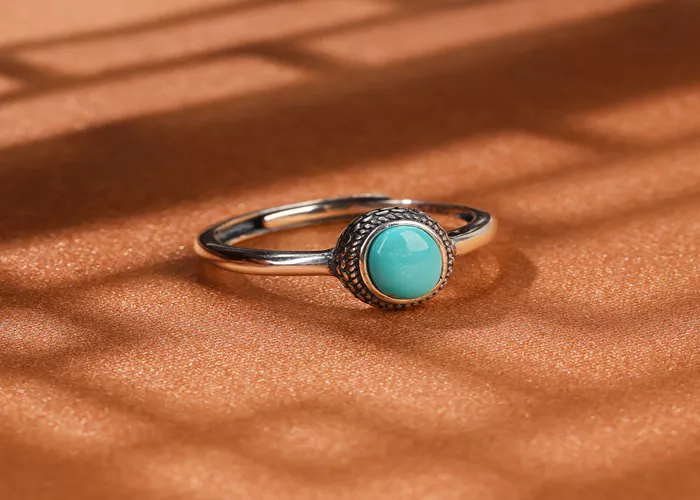When it comes to wearing a turquoise ring, the choice of which hand to adorn is often influenced by personal preference, cultural traditions, and even practical considerations. However, from a jewelry appraisal perspective, understanding the nuances of hand shapes, ring styles, and their interplay can help one make a more informed decision. This guide aims to provide a comprehensive introduction to the factors that influence which hand is suitable for wearing a turquoise ring, complete with subtitles and in a popular science style.
Understanding Hand Shapes
Short and Stubby Hands
Short and stubby hands are characterized by their compact length and relatively wide width. When choosing a ring for this hand shape, it’s crucial to opt for designs that can visually elongate the fingers. Vertical or oval-shaped turquoise rings are ideal as they draw the eye vertically, creating the illusion of longer fingers. Avoid overly wide or bulky rings, as they can emphasize the shortness and width of the fingers.
Long and Slender Hands
Long and slender hands are envied for their elegance and grace. With fingers that are both long and narrow, these hands can accommodate a wide range of ring styles. For turquoise rings, consider options with moderate widths. Rings that are too narrow can look disproportionate, while overly wide rings might overwhelm the delicate fingers. Instead, choose designs with some texture or width to balance the elegance of the hand while showcasing the beauty of the turquoise gemstone.
Balanced Hands
Hands that are balanced, with fingers of even length and width, are versatile in terms of ring choices. Turquoise rings with a variety of designs can complement this hand shape. Whether you prefer a simple band with a small turquoise cabochon or a more intricate setting with pave diamonds surrounding the turquoise, the key is to find a ring that reflects your personal style and enhances the overall harmony of your hand.
Fleshy Hands
Fleshy hands, often described as having softer, more rounded fingers, require rings that can balance out the fullness of the fingers. Turquoise rings with a slightly wider band or intricate designs can add visual interest without overwhelming the hand. Avoid rings that are too tight or narrow, as they can create an uncomfortable fit and draw attention to the fleshier aspects of the hand.
Knobby Hands
Knobby hands, characterized by prominent knuckles and bones, can be challenging to accessorize. However, turquoise rings with bold designs and textures can help distract from the knuckles and add a touch of sophistication. Opt for rings with intricate settings or a chunky band to create a balanced look.
Tapered Hands
Tapered hands, where the fingers gradually narrow towards the fingertips, are quite common. For these hands, turquoise rings with a streamlined design can complement the natural shape of the fingers. Rings that are neither too wide nor too narrow can strike the perfect balance, allowing the turquoise gemstone to shine while enhancing the elegance of the hand.
Cultural and Traditional Considerations
In many cultures, wearing rings on specific fingers or hands holds symbolic meaning. For instance, in Western traditions, the ring finger of the left hand is often chosen for engagement and wedding rings, as it is believed to have a vein that leads directly to the heart. While these traditions may not directly apply to turquoise rings, they do reflect the cultural significance attached to wearing rings.
In some Native American cultures, turquoise is considered a sacred gemstone with protective and healing properties. Therefore, the choice of which hand to wear a turquoise ring may be influenced by spiritual beliefs and practices. In these cases, wearing the ring on the hand that is closest to the heart or on a finger that is believed to have special powers can be meaningful.
Practical Considerations
When deciding which hand to wear a turquoise ring, practical considerations such as daily activities and comfort should also be taken into account. If you work with your hands frequently or engage in activities that could damage the ring, wearing it on a non-dominant hand might be more practical. Additionally, if you have a preference for wearing watches or other bracelets, coordinating the placement of your turquoise ring with these accessories can ensure a balanced and cohesive look.
Personal Style and Preference
Ultimately, the decision of which hand to wear a turquoise ring is highly personal. Your personal style, preferences, and comfort should guide your choice. Whether you prefer a bold statement ring that draws attention or a subtle accessory that complements your overall look, the key is to choose a ring that makes you feel confident and beautiful.
Care and Maintenance
Regardless of which hand you choose to wear your turquoise ring, proper care and maintenance are essential to preserve its beauty and value. Turquoise is a relatively soft gemstone, so it’s important to avoid exposing it to harsh chemicals, abrasive surfaces, or extreme temperatures. Regular cleaning with a soft cloth and warm water can help keep your ring looking its best.
Conclusion
In summary, the choice of which hand to wear a turquoise ring is influenced by a variety of factors, including hand shape, cultural traditions, practical considerations, and personal style. By understanding these nuances, you can make a more informed decision that enhances the beauty of your hand while showcasing the unique charm of a turquoise ring. Whether you opt for a bold statement piece or a subtle accessory, the key is to choose a ring that reflects your personal style and makes you feel confident and beautiful.
Related topic:
- Top 5 Heart Shaped Turquoise Rings for Engagements
- Caring for Your Tiny Turquoise Ring: Tips & Tricks
- How to Wear a Turquoise Ring


